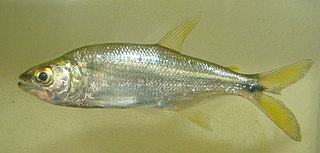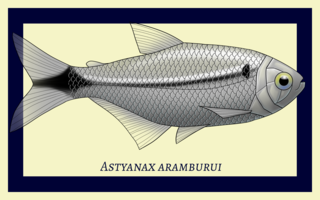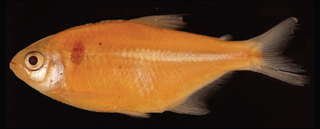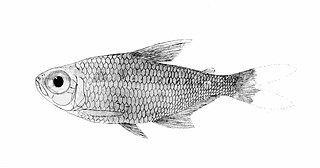
Characidae, the characids or characins, is a family of freshwater subtropical and tropical fish belonging to the order Characiformes. The name "characins" is an historical one, but scientists today tend to prefer "characids" to reflect their status as a, by and large, monophyletic group. To arrive there, this family has undergone much systematic and taxonomic change. Among those fishes remaining in the Characidae currently are the tetras, comprising the very similar genera Hemigrammus and Hyphessobrycon, as well as a few related forms, such as the cave and neon tetras. Fish of this family are important as food in several regions, and also constitute a large percentage of captive freshwater aquarium fish species.

Hyphessobrycon is a genus of freshwater fish in the family Characidae. These species are among the fishes known as tetras. The genus is distributed in the Neotropical realm from southern Mexico to Río de la Plata in Argentina. Many of these species are native to South America; about six species are from Central America and a single species, H. compressus is from southern Mexico.

Astyanax is a genus of freshwater fish in the family Characidae of the order Characiformes. Some of these fish, like many of their relatives, are kept as aquarium pets and known collectively as tetras. With around 150 described species and new ones being described yearly, this genus is among the largest of the entire order; Hyphessobrycon also has more than 145 species and which one is larger at any one time depends on whether more species have been recently described in one or the other. The blind and colorless cave tetra of Mexico is a famous member of the genus, but its taxonomic position is disputed: Some recognize it as part of the Mexican tetra and this is supported by phylogenetic evidence, but others recognize the cave form as a separate species, A. jordani.

Crenicichla is a genus of cichlids native to South America commonly known as the pike cichlids. They are found in most tropical and subtropical freshwater habitats between the Andes and the Atlantic.

Andromakhe is a genus of freshwater fish in the family Characidae of the order Characiformes.
Hisonotus is a genus of armored catfishes native to South America. Species of Hisonotus and Curculionichthys are the only representatives of the subfamily Otothyrinae having serrae on the posterior edge of the pectoral fin spine. These species are small fishes, generally found in small fast flowing streams, where they grasp to the branches and leaves of aquatic or subaquatic plants. The species of this genus mostly occur in Atlantic coastal streams of southern Brazil and the Paraguay-Paraná system of southern South America. They are also distributed in the Río de La Plata basin and coastal rivers of southeastern Brazil.

Moenkhausia is a genus of freshwater fish in the family Characidae native to tropical and subtropical South America. These are medium-sized tetras where the largest species only reach around 12 cm (4.7 in).

Bryconamericus is a genus of characins found in Central and South America.

Deuterodon is a genus of characins from river basins in southern and southeastern Brazil, with a single species of uncertain taxonomic status, D. potaroensis, from Guyana. These are small fish that reach up to 12.6 cm (5.0 in) in total length. They are omnivores with a specialized mouth structure that allows them to scrape algae and debris off bedrock.

Oligosarcus is a genus of characins from freshwater habitats in northern Argentina, Paraguay, Uruguay, eastern Bolivia, and southern and central Brazil. They reach up to 31 cm (12 in) in length and are predators that mainly feed on smaller fish.

Deuterodon pelecus is a species of characid fish from Brazil. It can be distinguished from other species by: its body depth ; its short and pointed snout smaller than the orbital diameter; and a reduced number of branched anal fin rays. D. pelecus also differs from members of its genus by its characteristic color pattern. It possesses a single humeral spot that is constricted to the region above the lateral line; at the same time it shows a conspicuous midlateral body stripe from opercle to the caudal fin base, an autapomorphy of this precise species. Other Deuterodon species have a humeral spot that is vertically or horizontally elongate and have the midlateral stripe becoming faint near that humeral spot. The species name is derived from the Greek pelekus, meaning "axe", referring to the pigmentation shape resulting from the adjoinment of the humeral spot with the midlateral stripe.

Carlastyanax aurocaudatus is a small species of freshwater fish in the family Characidae native to the Río Cauca in Colombia. It is the only member of the monotypic genus Carlastyanax, which was named in 1972 specifically for the species by Jacques Géry. Upon description, it was named Astyanax aurocaudatus by Carl H. Eigenmann. There has been debate concerning whether or not the genus should be recognized, but C. aurocaudatus is currently considered a valid species.

Astyanax abramis is a small freshwater fish from the inland rivers of South America. It is plentiful in almost the entire continent, with a habitat including the La Plata, upper Amazon, and Meta River basins. The body shape is subrhomboidal and laterally compressed, and the scales are largely silver, with a blue or green tint on the dorsal side.

Astyanax aramburui is a small freshwater fish from the rivers of South America, restricted to a relatively small region within the Paraná and Uruguay river basins of Argentina. It was named after the scientist who established a professional presence for ichthyology in the country, Raúl Arámburu. Considered a near-threatened species by the IUCN, its range includes creeks in a sub-basin affected by various forms of pollution.

Astyanax asuncionensis is a small species of freshwater fish described in 1972 from Asunción, the capital of Paraguay in South America. Its specific epithet is in reference to this. Currently, its range is known to encompass areas of not just Paraguay but also Argentina and Brazil. It is an adaptable, omnivorous species that easily lives in sympatry with various congeners.

Astyanax brachypterygium is a small species of freshwater fish endemic to a collection of high-elevation streams in Brazil. It was named in 2001 alongside congener Astyanax cremnobates, to which it bears a strong resemblance; physical details help to differentiate between the two. Its scales are a greenish-brown on the back and silver on the belly, with reddish fins and a dark humeral spot. One of its defining features is a notably short anal-fin base, which has 13 to 15 rays.

Deuterodon heterostomus is a small species of characin endemic to a large river system in southeast Brazil. It was originally the only member of the genus Probolodus, but Probolodus is now considered obsolete, synonymized with Deuterodon. Much like other members of Deuterodon, and like some fish in related genera, D. heterostomus is a small, silvery fish with fins in some combination of red and clear. It has a defined humeral spot that can be used for identification.

Deuterodon oyakawai is a small species of characin endemic to a large river basin along the Atlantic coast in southeast Brazil. It was originally one of three members of the genus Probolodus, but Probolodus is now considered obsolete, synonymized with Deuterodon. Much like other members of Deuterodon, and like some species in related genera, D. oyakawai is a small, silvery fish with fins in some combination of red and clear. It has a defined humeral spot that can be used for identification.

Deuterodon sazimai is a small freshwater fish endemic to a handful of river basins in southeastern Brazil. Upon being first described, it was considered a member of genus Probolodus; Probolodus is now considered obsolete, synonymized with Deuterodon. Much like other members of Deuterodon, and like some species in related genera like Astyanax or Jupiaba, D. oyakawai is a silvery fish with fins in some combination of red and clear. It sports a wedge-shaped humeral spot, and an oval-shaped blotch on its tail joint.

Makunaima is a genus of freshwater fish in the family Characidae of the order Characiformes.



















